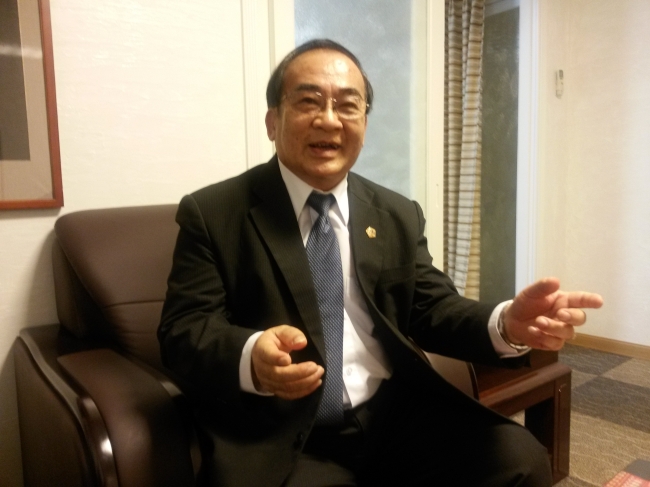Profile of Laos on the rise
Following historic summit, Vientiane is to receive increased attention from Korea
By Korea HeraldPublished : Feb. 23, 2014 - 19:59
Ties between Laos and South Korea have been riding on an unprecedented high ever since Laotian President Choummaly Sayasone’s historic visit to South Korea in November 2013 that generated a slew of bilateral agreements.
Sayasone made a three-day trip to South Korea on Nov. 21, 2013, that included summit talks with President Park Geun-hye on Nov. 22 on ways to expand economic, political and cultural cooperation and exchanges.
“A wide range of issues has been discussed including political affairs, economic and trade cooperation, tourism and cultural and people-to-people interactions in order to enhance bilateral relations between the two countries,” said Laotian Ambassador to South Korea Khamla Xayachack in an interview with The Korea Herald on Feb. 10. “We therefore must bring these matters into action to meet the success as much as possible.”
Sayasone made a three-day trip to South Korea on Nov. 21, 2013, that included summit talks with President Park Geun-hye on Nov. 22 on ways to expand economic, political and cultural cooperation and exchanges.
“A wide range of issues has been discussed including political affairs, economic and trade cooperation, tourism and cultural and people-to-people interactions in order to enhance bilateral relations between the two countries,” said Laotian Ambassador to South Korea Khamla Xayachack in an interview with The Korea Herald on Feb. 10. “We therefore must bring these matters into action to meet the success as much as possible.”

The presidential summit marked the first-ever visit between Laos and South Korea since the two countries reopened diplomatic relations in 1995. Though ties were first forged in 1974, the relationship was cut short when the communist Pathet Lao and its supporters in North Vietnam defeated the royalist forces and their American backers.
Laos and South Korea signed MOUs on grant-type aid from the Korea International Cooperation Agency and on loans from the Economic Development Cooperation Fund, and a cooperation agreement on preserving historic sites in the Champasak region of southern Laos.
South Korea plans to extend $200 million from the EDCF to Laos over the next three years.
South Korea extended $18 million in overseas development grants to fund nine projects in 2010 and 2011. SK Engineering & Construction and the Korean Western Power Company are building the 410-megawatt Xe Pian Xe Namnoy hydroelectric power station in the southern part of the country. The ambassador said he expects it to be completed by 2018.
One sticking point in the relationship is Laos’ closeness with North Korea.
Laos was the object of criticism here in May last year for deporting nine young North Koreans to China, where they were repatriated back to North Korea.
Last month, a 17-year-old North Korean girl surnamed Ri reportedly entered the South Korean Embassy in Laos.
But the refugee issue could be just a speed bump on the road toward stepped-up South Korean investment in Laos.
From 1989 to 2012, cumulative South Korean FDI in Laos was $740 million, making it one of the top 10 investors there.
The 64-year-old Xayachack said he finds further cause for optimism increasing people-to-people exchanges. Some 60,000 South Koreans visited Laos last year, a 50 percent increase in two years.
“I hope every tourist visiting Laos will be happy due to Laos, a peaceful country with beautiful landscapes in many places from north to south,” Xayachack said.
Airlines in Laos and South Korea operate direct flights and Laos has recently made it a national policy to develop tourism infrastructure. The envoy explained that his country “has declared the implementation, development and promotion of cultural tourism, natural tourism and historical tourism.”
“Korea and Laos have witnessed a deepening and broadening exchange underpinned by the hallyu phenomenon rippling across Southeast Asia,” he said.
Laotian artists conducted intensive master dances in South Korea. This has increased awareness of Laotian culture here, the ambassador said.
Xayachack has 43 years of experience working in the area of international relations. After graduating from high school in Vietnam in 1971, he returned to a liberated zone of Laos in Houaphanh province, in the northeast part of the country and bordering Vietnam.
In the late 1970s, he studied at Moscow Institute for International Relations for six years, returning to enter the Laotian Ministry of Foreign Affairs. He has previously served postings in Germany and the United States.
By Philip Iglauer (ephilip2011@heraldcorp.com)
-
Articles by Korea Herald







![[Weekender] How DDP emerged as an icon of Seoul](http://res.heraldm.com/phpwas/restmb_idxmake.php?idx=644&simg=/content/image/2024/04/25/20240425050915_0.jpg&u=)



![[KH Explains] No more 'Michael' at Kakao Games](http://res.heraldm.com/phpwas/restmb_idxmake.php?idx=644&simg=/content/image/2024/04/28/20240428050183_0.jpg&u=20240428180321)







![[Herald Interview] Mistakes turn into blessings in street performance, director says](http://res.heraldm.com/phpwas/restmb_idxmake.php?idx=652&simg=/content/image/2024/04/28/20240428050150_0.jpg&u=20240428174656)
